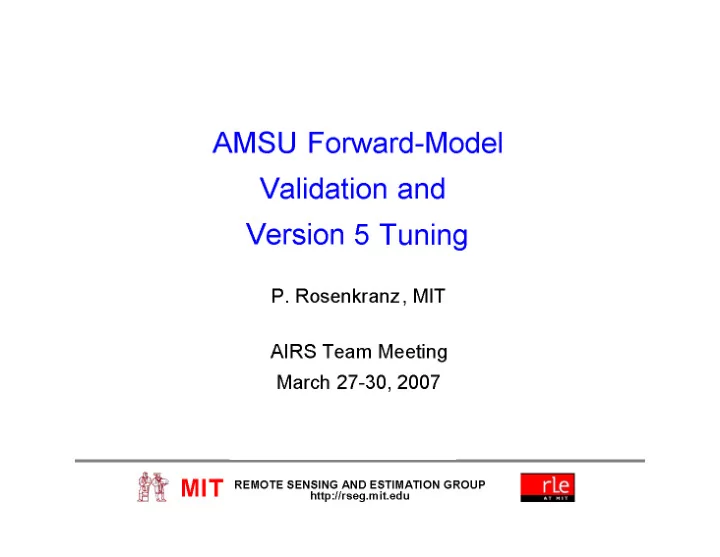

Dependence of AMSU-A Brightness Temperatures on Bistatic Surface Scattering (in cooperation with C. Mätzler, U. Bern) Polar firn ice frequently exhibits significant surface reflectivity (0.1 to 0.3), and AMSU channels 3, 4 and 5 are sensitive (up to a few degrees K) to the angular distribution of reflected down-welling sky emission. The Level-2 PGE assumes Lambertian scattering from ice surfaces; experimental support has now been obtained for this assumption from AMSU measurements at 50.3 and 52.8 GHz in the vicinity of Dome C, Antarctica.
The brightness temperature that would be observed by a radiometer positioned just above the surface is: T B0 = ( T Btoa - T direct ) / upward_trans. T Btoa is measured by AMSU; an AIRS temperature-profile retrieval (v4.6) at Dome C was used to calculate the atmospheric emission T direct and transmittance on the direct path to the satellite. T B0 contains two components, the surface emission and the reflected sky brightness. We make the assumption that surface emission and reflectivity are nearly the same at 50.3 as at 52.8 GHz; then subtract to eliminate the surface emission term: T B0 (52.8 GHz ) - T B0 (50.3 GHz) = r [ T sky (52.8 GHz ) - T sky (50.3 GHz) ] T sky = effective downwelling sky brightness temperature (calculate from AIRS profile) r = reflectivity
The difference on the left side of the previous equation is plotted (by the circles) for 17 overpasses, along with curves for Lambertian and specular surface reflection. The curves were calculated from the right side of the equation, setting r =0.242 to match the observations near 46°, where the two curves intersect. (Based on 31.4 GHz data, r is assumed to be constant with angle for the specular case.) The angular dependence of the reflected sky emission agrees with a Lambert model within the scatter of the measurements.
What's New in Version 5 Microwave 1. AMSU-A tuning was adjusted to obtain consistency with AIRS measurements. Brightness temperatures were computed from temperature and moisture retrievals prepared by C. Barnet and E. Maddy, NOAA-NESDIS, from AIRS measurements in clear- air ocean cases from the period August 2003 to December 2005. (See March 2006 presentation.) The tuning is a bias dependent only on channel and scan position. However, the software is capable of using both bias and slope parameters (for V6). 2. A test for warm surface temperature was added to the surface classification routine to eliminate some spurious sea-ice detections that result from rain contamination. 3. When HSB data is absent, the apriori value of the condensation point in the microwave- only retrieval is set to 116% relative humidity over land surfaces. This eliminated a trap involving excessive water vapor and unrealistic liquid water over deserts, which caused the version-4 retrieval to be rejected and prevented the Level-2 PGE from proceeding to later stages.
Bias-only (red) compared to V.4 bias (black, which was tuned to ECMWF): All are more negative than V.4, but chan. 13 still has a more positive bias than the others.
Recommend
More recommend